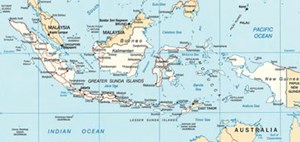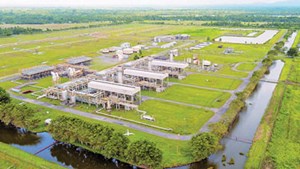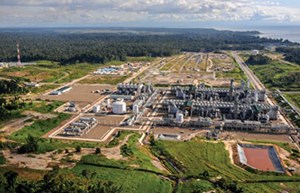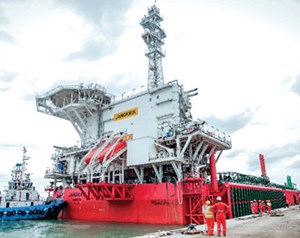Filled with abundant resources, hope for increased activity
Indonesian oil and gas development has seen some difficult times. From overregulation to aging infrastructure, the country finds it difficult to secure investors. Now that regulations have been streamlined, Indonesia hopes that new growth funded by super-majors will meet regional energy demands, provide renewed exports, and perhaps offer a reason to re-join OPEC.
According to the International Energy Agency (IEA), Indonesia is Southeast Asia’s largest gas supplier, with exports accounting for roughly 45% of its production. Worldwide, Indonesia is the tenth-largest gas producer and the seventh-largest exporter of LNG. And World Oil’s most recent figures show Indonesia producing about 800,000 bopd, with oil and gas reserves of 3.2 Bbbl and 103.0 Tcf, respectively. Drilling has amounted to between 300 and 400 wells annually in the last couple of years.
Indonesia’s oil production has been on a generally downward trend since the mid-1990s, and that trend was exacerbated by the global plunge in oil prices that began in late 2014, although output appears to have bottomed out in the last couple of years. Oil production declines were the result of a lack of major, new production projects. Aging infrastructure and declines in older fields added to the country’s struggle to meet production targets in the short term. As recently as a year ago, Wood Mackenzie’s January 2018 report noted that Indonesia’s “exploration and development activity has been negatively impacted by regulatory and fiscal uncertainty, with the 2012 dissolution of BPMIGAS, and a recent series of negative regulations affecting investor confidence.”
In addition, the island nation has had an on-again, off-again relationship with OPEC over the last 10 years. Having joined the group in 1962, Indonesia left in 2009, when falling production meant that the country had become a net importer of crude oil, which is against OPEC’s rules for full membership. But then, in January 2016, Indonesia rejoined OPEC, only to leave again in November 2016, under a “temporary suspension.” Yet, two years later, the nation has still not returned to the group.
SOUTH CHINA SEA DISPUTES
Like its Southeast Asian neighbors, the Philippines, Vietnam, Malaysia and Brunei, Indonesia continues to joust politically with China over territorial claims in the South China Sea, in response to repeated Chinese actions. During July 2017, in an attempt to assert its sovereignty, Indonesia renamed the northern portions of its exclusive economic zone in the South China Sea as the North Natuna Sea. This is north of the Natuna Islands, bordering the southern part of Vietnam’s exclusive economic zone, which is the southern end of the South China Sea. The Natuna Sea is south of Natuna Island and within Indonesian territorial waters. Thus, Indonesia has named two seas that are portions of the South China Sea, partially in an attempt to protect upstream activity in areas that it deems to be its territorial waters.
EFFORTS TO BUILD E&P ACTIVITY
During first-quarter 2018, The Ministry of Energy and Mineral Resources (ESDM) of the Republic of Indonesia launched a road show to recruit investors to bid on 24 onshore and offshore blocks, one coalbed methane block and one shale block. The goal was to receive bids for at least half of the offerings, with an additional bidding round scheduled in six months, according to Deputy Minister Arcandra Tahar. The larger vision is to raise $200 billon in new investments by 2030.

However, an attempt to license 10 blocks in 2017, resulted in only five awards, as the country’s aging fields drew little attention from oil majors. As a result, the government switched to production-sharing contracts (PSCs) with a “gross-split scheme” to entice explorers. The new regulation, in part, replaced 50 previous regulations and aims to provide more certainty, flexibility and transparency for oil investors, Tahar said.
“With gross split, there is a certainty that you, yourself, count the split,” Tahar told Bloomberg. Explorers will get greater incentives, if crude prices are low, and it will be reduced when prices move higher, he said.
These drastic changes have resulted in some success, so far. During the third round of bidding for blocks in Indonesia, Tahar announced in late December 2018, the winners of the Phase III Oil and Gas Work Area (WK) Offer in 2018, which was held from Nov. 5, 2018, until Dec. 21, 2018. According to the ESDM website, the winners are Pearloil (Theralite) Ltd. for the South Andaman Block, offshore Andaman Aceh; Talisman Java B. V. and Mitsui Oil Exploration Co. Ltd. for the South Saka Kemang Block, onshore South Sumatra; and Pertamina for the Maratua Block, which is both onshore and offshore North and East Kalimantan. However, there was no winning bid for the Anambas Block, offshore West Natuna. The investment value of these three fixed commitments is $10.9 million, and the total signature bonus is $6 million. The Anambas Block will be offered again during the next bidding round period.
In addition to leasing sales, Indonesia aims to boost production within the country. PT Pertamina, an upstream business subsidiary of state-owned oil and gas holding company Pertamina, has major plans to supply 60% of Indonesia’s oil production, according to PT Pertamina Commissoner Sahala Lumbangaol. This achievement will make the company Indonesia’s “biggest oil producer.”
Areas of interest. Within Indonesia, there are considerable amounts of oil in Sumatra, Java, Kalimantan Sulawesi and Natuna Island. The country contains about 60 basins across the country, only 22 of which have been explored and exploited, according to IEA, Fig. 1.
OPERATOR ACTIVITY
Pertamina. In relation to the previous comments made about the state oil company, Pertamina has been tidying up operations at the North Sumatra B (NSB), (Fig. 2) and North Sumatra Offshore (NSO) Blocks. The firm acquired these two blocks in 2015 from the original operator, ExxonMobil. During the three years since then, the blocks have been managed by Pertamina subsidiary PT Pertamina Hulu Energi NSB & NSO. In managing these well assets and relatively old facilities, the firm has managed to maintain production rates at both blocks and actually build them higher.

“The performance of gas production in the first half of 2018 reached 153.02 MMcfgd, or 141% of the target of 2018, 108 MMcfgd,” said PHE NSB & NSO General Manager Akmad Miftah last July. Similarly, condensate production continued to run above the target for two consecutive years. In fact, during first-half 2018, output averaged 1,896 bcpd, or 102% of the target of 1,859 bcpd.
In an effort to increase the reserves-to-production ratio, PHE NSO has planned to drill three exploration wells, with one spudded by the end of 2018, and the next two to be drilled later in 2019. Workover activity in first-half 2018 included four wells.

Chevron. The company’s operated interests include the Rokan PSC on the island of Sumatra Minas. The Minas field, in Riau on Sumatra, is the largest oil block in Indonesia, according to the company. Output from the field is between 20% and 25% of Chevron’s annual oil production in the country. In addition, the U.S. firm operates Duri field (Fig. 3), in Bengkalis Regency, Riau, Sumatra. Duri field has applied steamflood technology since 1985 to increase recovery of heavy oil. It is one of the largest steamflood developments in the world. Indonesia has decided that Pertamina will take over operation of the Rokan oil block, the country’s second-biggest crude-producing field, once Chevron’s operating contract expires in 2021.
Chevron also operates interests offshore eastern Kalimantan, including four PSCs in the Kutei basin—East Kalimantan (92.5%), Makassar Strait (72%), Rapak (62%) and Ganal (62%). The company has a 62% operated interest in the Bangka Project, the first stage of the Indonesia Deepwater Development Project in East Kalimantan. Production began in 2016. Net daily production from Bangka in 2017 averaged 49 MMcfg and 2,000 bbl of condensate.
The Bangka project includes a subsea connection to a floating production unit (FPU), and has a design capacity of 110 MMcfg and 4,000 bocd. An FID was reached in 2014, following government approvals. The project began with the drilling of two development wells during second-half 2014. “We are proud that the Bangka field development also marks Indonesia’s innovative history to be the first deepwater subsea tie-back, the longest flexible pipeline installed, and the first single umbilical installed,” said Adimas Krishna Pribadi, Bangka’s subsea manifold engineer.
ConocoPhillips has played a role in Indonesia for more than 45 years, operating three onshore blocks—the Corridor Block and the South Jambi ‘B’ PSC, both in South Sumatra, and the Kualakurun PSC in Central Kalimantan. The 809-mi2 Corridor Block consists of two active oil fields (Suban Baru and Rawa) and seven gas-producing fields, principal of which are Suban, Sumpal and Dayung. Suban was unitized in 2011. Ongoing investment to maintain gas production includes development drilling (Sumpal, Suban), and construction of additional compression at Suban.
The South Jambi ‘B’ PSC’s existing fields have been depleted. ConocoPhillips and its co-venturers are evaluating options for the PSC’s future. ConocoPhillips entered the Kualakurun PSC in 2015. During 2017, the company acquired 740 km of 2D seismic, with assessment ongoing.
ExxonMobil. Cepu field, in Java, is operated by ExxonMobil subsidiary Mobil Cepu Ltd, and was discovered in March 2001. It is estimated to have proven reserves of 600 MMbbl of oil and 1.7 Tcfg. Output rose from around 20,000 bopd in early 2012 to around 165,000 bopd in late 2014.
Banyu Urip field is a major field for Indonesia in the Cepu Block, in Bojonegoro Regency, East Java, and operated by ExxonMobil (45%). Pertamina holds an additional 45% interest. Oil production achieved a peak production rate of 165,000 bopd in first-quarter 2016 and produces over 20% of Indonesia’s oil production. The project consists of production processing facilities that include 45 drilled wells, and a 60-mi pipeline to transport the processed oil to a 2.1-MMbbl FSO unit.
Husky Energy/CNOOC. Husky is advancing gas projects in the Madura Strait offshore Indonesia. These include the liquids-rich BD Project and the shallow-water MDA-MBH and MDK fields. The BD Project achieved first production in 2017. The MDA-MBH and MDK fields are being developed in tandem, with first gas anticipated in 2020.
The company holds a 40% interest in these fields, which are being developed in partnership with operator CNOOC Limited and an affiliate of Samudra Energy Ltd., an Indonesian company.
Additional natural gas discoveries in the Madura Strait are being evaluated for commercial development.
Santos. Last May, Santos sold its Indonesia assets as part of a late-life non-core assets strategy, making many Asian country exits. In the transaction, 67.5% of the Madura Offshore PSC (Maleo and Peluang gas fields), was sold to Ophir Energy. This was part of a $221-million transaction. Proceeds from the sale were to be applied to Santo’s debt at $2.5 billion.

BP. Tangguh field in Bintuni Bay (Fig. 4), West Papua, is operated and 100%-owned by BP. It is estimated to have proven gas reserves of 4.4 Tcfg, with a goal to reach production of 7.6 MMt of LNG. Tangguh LNG is a unitized development of six gas fields located in the Wiriagar, Berau and Muturi PSCs in Bintuni Bay, Papua Barat. In addition, Add Energy, in partnership with Indonesian partner, PT Synergy Engineering, has been awarded a maintenance build contract for work on the Tangguh LNG expansion project, as reported in March 2018.
Eni. Merakes gas field is in the Kutei basin, offshore East Kalimantan, at a water depth of 4,495 ft. It was discovered in October 2014, with an initial gas-in-place estimate of 1.3 Tcf. In January 2017, the Merakes-2 appraisal confirmed an upside, and the gas-in-place estimate was increased to 2 Tcf.
In April 2018, Eni fast-tracked the field’s plan of development, with the approval of ESDM. This development plan included the drilling and completion of six subsea wells, and the construction and installation of subsea systems and pipelines which will be connected to the Jangkrik FPU, Fig. 5. In December 2018, the field development was sanctioned as a tie-back to the Jangkrik FPU, 22 mi northeast. First gas is expected in 2021, according to the company. Gas production will be shipped to the Bontang LNG plant.
Eni’s board approval comes shortly after Indonesia’s conversion to the gross-split scheme for the East Sepinggan PSC, and the approval of the revised field development plan under those terms.
Eni CEO Claudio Descalzi said, “The Merakes Development Project approval is an important step for our strategy in Southeast Asia, aimed at increasing both our presence and our production through organic growth.”
Also in December, Eni reported that it successfully drilled and tested the Merakes East well. The well was drilled to a depth of 11,155 ft in 5,223 ft of water, and encountered 49 ft of gas-bearing net sands in two distinct levels of Miocene age. Analysis of test data shows that in production configuration, the well can deliver 70 MMscfd of gas and 1,000 bpd of associated condensate.
Eni has been operating in Indonesia since 2001, and has a large portfolio of assets in exploration, production and development. As operator of the East Sepinggan Contract Area through its subsidiary. Eni East Sepinggan Limited, the company holds an 85% interest, while PT Pertamina Hulu Energi East Sepinggan holds the remaining 15%.
Premier Oil. Premier has a 28.67% operated interest in the producing license of Natuna Sea Block A in Indonesia. The Natuna Sea Block A consists of four separate producing fields that have been developed via a combination of platforms and subsea tie-backs to the Anoa facility and the Gajah Baru WHP and CPP.
West Natuna Exploration Limited (WNEL). This local firm is owned by Conrad Petroleum (90%) and Empyrean Energy PLC (10%). In turn, WNEL holds 100% of the Duyung PSC offshore Indonesia, as of August 2018. The contract covers an offshore permit of approximately 1,100 km2 in the prolific West Natuna basin. The main asset in the block is the Mako shallow gas discovery. In addition, numerous prospects and leads have been identified in the block, using 3D seismic data.
Empyrean participated in the appraisal well Mako South-1, drilled in June 2017. The well was drilled, using a jackup rig in a water depth of 308 ft. The well reached TD on June 22, 2017. ![]()
- Advancing offshore decarbonization through electrification of FPSOs (March 2024)
- U.S. oil and natural gas production hits record highs (February 2024)
- Driving MPD adoption with performance-enhancing technologies (January 2024)
- What's new in exploration (November 2023)
- What's new in production (October 2023)
- Rig electrification drives down emissions, bolsters efficiency while improving onshore drilling economics (October 2023)



